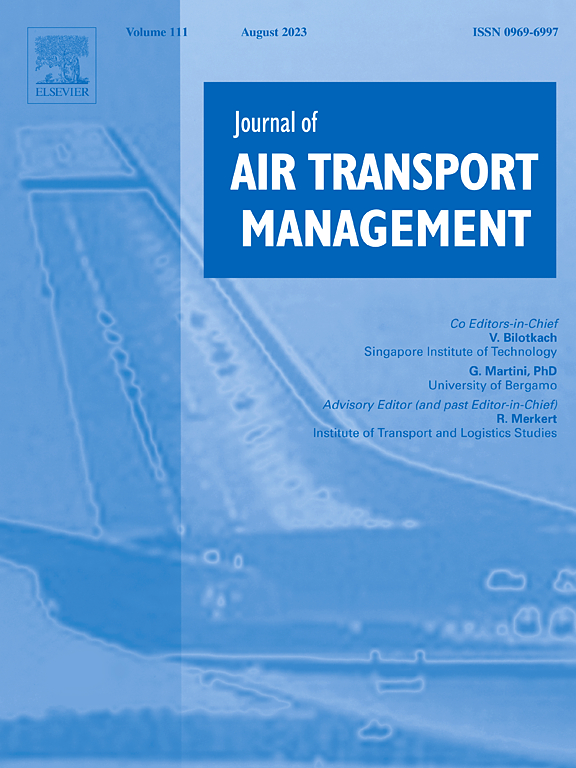Multi-objective four-dimensional trajectory planning for free-route operations considering weather forecast uncertainty
IF 3.6
2区 工程技术
Q2 TRANSPORTATION
引用次数: 0
Abstract
Free-route Operations (FRO) represent a significant shift in the future air traffic management, offering enhanced system capacity and operational efficiency. However, there remains a lack of trajectory management methods tailored to FRO that can effectively address the challenges of unstructured traffic flows, high traffic complexity, and uncertain weather conditions. This paper proposes a novel multi-module framework for 4D free-routing trajectory management, including trajectory prediction, airspace configuration, and strategic and tactical trajectory planning. Trajectory prediction incorporates ensemble-based weather forecasts to address uncertainty. A routing method tailored to FRO is adopted, combining a two-layer network with a K-shortest path algorithm to generate alternative routes. The core of this framework is a strategic trajectory planning method, integrating flow management and conflict management to optimize safety, efficiency, and flexibility. A complexity metric based on the linear dynamical system is adopted for safety evaluation. A distributed multi-objective optimization method is designed based on the decomposition mechanism, solving subproblems in parallel. The proposed framework is validated through a simulation scenario based on historical data from the western China airspace. Results demonstrate that the proposed method reduces operational risk by 88.52 % and increases flexibility by 51.66 %, with only a 6.84 % increase in cost. Additionally, trade-offs among three objectives are identified from non-dominated solutions, and a multi-criteria decision-making method guides the selection of the ideal solution and maneuver type. The proposed method also demonstrates high computational efficiency, making it a practical decision-support tool for future free-route operations.
考虑天气预报不确定性的自由航路作业多目标四维轨迹规划
自由航线操作(FRO)代表着未来空中交通管理的重大转变,提供了更高的系统容量和操作效率。然而,目前仍然缺乏为FRO量身定制的轨迹管理方法,无法有效应对非结构化交通流、高交通复杂性和不确定天气条件的挑战。提出了一种新型的多模块四维自由航路弹道管理框架,包括弹道预测、空域配置和战略战术弹道规划。弹道预测结合了基于集合的天气预报来解决不确定性。采用了一种针对FRO的路由方法,将二层网络与k -最短路径算法相结合,生成备选路由。该框架的核心是一种战略轨迹规划方法,将流量管理和冲突管理相结合,以优化安全性、效率和灵活性。采用基于线性动力系统的复杂度度量进行安全评价。基于分解机制,设计了分布式多目标优化方法,并行求解子问题。通过基于中国西部空域历史数据的仿真场景验证了所提出的框架。结果表明,该方法降低了88.52%的操作风险,提高了51.66%的灵活性,而成本仅增加了6.84%。此外,从非支配解中确定了三个目标之间的权衡,并采用多准则决策方法指导理想解和机动类型的选择。该方法具有较高的计算效率,为未来自由航路作业提供了实用的决策支持工具。
本文章由计算机程序翻译,如有差异,请以英文原文为准。
求助全文
约1分钟内获得全文
求助全文
来源期刊

Journal of Air Transport Management
TRANSPORTATION-
CiteScore
12.40
自引率
11.70%
发文量
97
期刊介绍:
The Journal of Air Transport Management (JATM) sets out to address, through high quality research articles and authoritative commentary, the major economic, management and policy issues facing the air transport industry today. It offers practitioners and academics an international and dynamic forum for analysis and discussion of these issues, linking research and practice and stimulating interaction between the two. The refereed papers in the journal cover all the major sectors of the industry (airlines, airports, air traffic management) as well as related areas such as tourism management and logistics. Papers are blind reviewed, normally by two referees, chosen for their specialist knowledge. The journal provides independent, original and rigorous analysis in the areas of: • Policy, regulation and law • Strategy • Operations • Marketing • Economics and finance • Sustainability
 求助内容:
求助内容: 应助结果提醒方式:
应助结果提醒方式:


